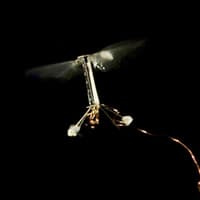
Harvard researchers have extended the flight time of their insect-sized RoboBee device by copying the way small bugs descend onto walls and ceilings. The RoboBee, which first flew in 2012, is now able to conserve more of its energy by landing between jaunts in the same style as a bee or butterfly would before taking off again.
Expected to take part in surveillance missions, crop monitoring, and search and rescue operations, the RoboBee is crafted from layers of laser-cut carbon fiber and weighs about 100 mg. It flaps its gossamer-like plastic wings back and forth at 120 beats per second, but an external source currently powers it through a wire tether. When scientists discovered this new landing method, the robot’s design integrated a combination of electrostatic material and a foam mount to create a new built-in robot landing pad. The new plan was a solution to avoid using intricate systems that a perching method would usually require.
“A lot of different animals use perching to conserve energy,” said Kevin Ma, a co-author of the study. “But the methods they use to perch, like sticky adhesives or latching with talons, are inappropriate for a paperclip-size microbot.”

When charged, this electrostatic material can attach itself to nearly any surface that responds to static electricity, allowing the overall technology to work well both on the ground and the ceiling. These updates cause the RoboBee’s electrode patch to use 1,000 times less power than the device did when hovering in the air.
“The use of adhesives that are controllable without complex physical mechanisms, are low power, and can adhere to a large array of surfaces is perfect for robots that are agile yet have limited payload – like the RoboBee,” said Robert Wood, senior author of the study. “When making robots the size of insects, simplicity and low power are always key constraints.”
Electrostatic adhesion has been used in robot research before but is especially helpful in this project because adhesion can be turned on and off without a need for moving parts. The presence of adhesion also means the RoboBee can land, perch, and take off without applying any force to its landing surface. However, the device’s electrode patch is only fitted to its top surface, limiting the RoboBee to perch just on vertical and overhanging surfaces.
Fixing this design restriction is next on the researchers’ list of tweaks for the RoboBee, along with removing tether wires and integrating power and flight control technology.
Advertisement
Learn more about Electronic Products Magazine





